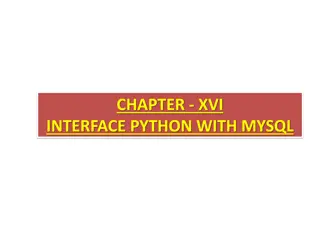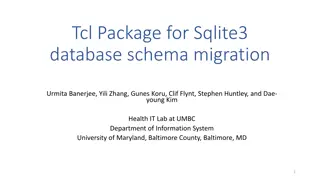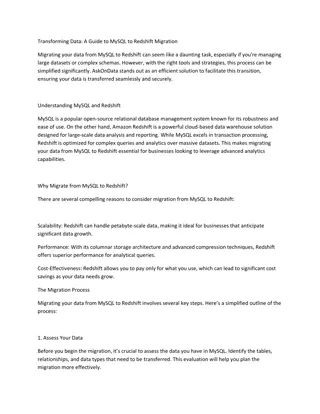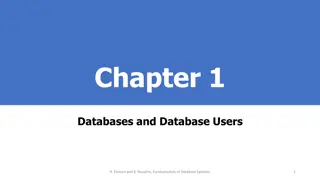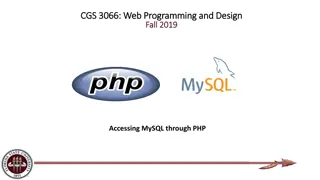Guide to MySQL Operations on Turing Server
This guide provides step-by-step instructions on working with MySQL on Turing server at turing.csce.uark.edu. It includes logging in via SSH, connecting to the server, changing MySQL passwords, and performing operations on tables. Learn how to create tables, change passwords, and more with detailed
4 views • 21 slides
National Database of Cooperatives: Ministry of Cooperation Initiatives
The Ministry of Cooperation is developing a National Database of Cooperatives to enhance transparency, governance, and policymaking in the cooperative sector. The database aims to provide comprehensive information on cooperatives across sectors, improve coordination among stakeholders, and facilitat
0 views • 22 slides
Database Design Principles and Management Overview
This document presents an overview of database design principles, including structured, semi-structured, and unstructured data types. It delves into the role of Database Management Systems (DBMS) in defining, constructing, manipulating, and sharing databases effectively. It also covers various types
0 views • 47 slides
Introduction to Database Management System Explained
This presentation covers the basics of database management systems, including definitions of data, types of data, structured and unstructured data, storing data in computers using file systems and database systems, and issues with file systems like data redundancy, inconsistency, difficult data acce
3 views • 18 slides
Oracle 19c Standard Edition: RAC Migration and Database Solutions Overview
Explore the implications of Oracle Database 19c Standard Edition no longer supporting RAC, and learn about disaster recovery and high availability options for users. Delve into the differences between HA and DR, along with the significance of workload isolation and scalability in database management
4 views • 22 slides
Database Management Systems (DBMS)
A Database Management System (DBMS) is a crucial tool for organizing, storing, and managing data efficiently. It allows users to create, update, retrieve, and delete data effectively, ensuring data consistency and security. DBMS software like MySQL and Oracle provide interfaces for various database
2 views • 21 slides
Costs and Risks of Implementing a Database Approach
Implementing a database approach involves additional costs and risks that need to be managed effectively. From hiring specialized personnel to dealing with conversion costs and organizational conflicts, organizations must carefully consider the implications of transitioning to a database system. The
2 views • 10 slides
Database Design Process and Concepts
This lecture on designing databases covers the database design process, normalization, transforming E-R diagrams, physical database design concepts, and steps in logical database modeling. It highlights the importance of logical and physical database design in system development, providing insights
1 views • 64 slides
Interactive Hololens Tour Project Overview
This project involves creating a Microsoft Hololens heads-up display for an interactive tour of the ASU campus. It includes showcasing landmarks and a Twitter feed displaying geo-tagged tweets. The motivation stems from enhancing self-guided tour experiences for prospective students, potentially aid
1 views • 15 slides
Python Interface with MySQL: Database Programming Basics
Python provides powerful features for database programming, allowing interaction with databases like MySQL, Oracle, and more. The Python DB API is a widely used module that enables creating, accessing, and manipulating data. An interface acts as a bridge between applications and systems, facilitatin
3 views • 80 slides
Importing and Exporting Data Between CSV Files, MySQL, and Pandas
In this chapter, we explore how to transfer data between CSV files, MySQL databases, and Pandas using Python. We learn about the CSV file format, creating CSV files, and reading data from CSV files into Dataframes. This chapter provides insights into efficient data management techniques using Pandas
1 views • 11 slides
Entity-Relationship Diagrams (ERD) for Database Design
Entity-Relationship Diagrams (ERD) are vital in database design, illustrating entities and their relationships. They help in conceptualizing data models and laying the groundwork for database structures. The process involves identifying entities, defining relationships, and analyzing interactions to
1 views • 40 slides
Database Security Measures and Controls
Database security is crucial to protect against threats like loss of integrity, availability, and confidentiality. Countermeasures such as access control, inference control, flow control, and encryption are important for safeguarding databases. Access control involves creating user accounts and pass
1 views • 35 slides
Performers and Programs Database Webinar - Overview and Features
Learn about the Performers and Programs Database Webinar happening on October 22, 2021. This webinar, presented by Peter Kowalski and introduced by Sharon B. Phillips, offers valuable information about the database's features, including how performers advertise programs, categorization, virtual prog
1 views • 25 slides
Introduction to Database Systems and SQL Programming
Understanding database systems is crucial in today's digital world. Explore the basics of database systems, SQL statements, and Java Database Connectivity (JDBC) in this comprehensive overview. Learn about DBMS, SQL querying, JDBC API, and more to enhance your understanding of managing and interacti
10 views • 24 slides
Overview of Database Systems Architecture and Languages
A database system is essential for storing and managing an organization's data. The architecture includes components like file manager, database manager, and query processor. Additionally, DML and DDL compilers play crucial roles in handling data manipulation and definition tasks. Various data struc
2 views • 28 slides
Database Management Systems and Concepts
Explore the world of databases with topics ranging from Database Creation and Management to Basic Database Terms. Learn about the significance of data, information, and metadata in decision-making processes. Discover the purpose of database systems and the role of Database Management Systems (DBMS)
2 views • 25 slides
Database Implementation Issues in Programming Studio
Key topics covered in the slides include database implementation issues, storing data efficiently, and strategies for handling variable length fields in tuple storage. The presentation delves into specialized algorithms for database efficiency and reliability, terminology related to database impleme
0 views • 32 slides
Efficient SQL Database Maintenance for Performance
Learn to effectively clean and optimize your SQL database for optimal performance. Discover tools like Ola Hallengren's Maintenance Solution and Brent Ozar's First Responder Kit, along with best practices for backup, restore, index optimization, and database integrity checks. Ensure a healthy databa
0 views • 17 slides
Guide to Importing and Organizing Station Catalogs and Weather Data
This guide provides step-by-step instructions on how to create a new database for fire-related data, name the database, save it in a specific folder, open the database, and import station catalogs and weather data. The process involves creating a fire family plus database, naming and saving it prope
0 views • 18 slides
Getting Started with PHP MySQL - Connecting and Manipulating Databases
PHP allows you to connect to MySQL databases for efficient data manipulation. Discover what MySQL is, how it works, and ways to establish a connection using MySQLi and PDO extensions. Learn about storing data in tables and executing code examples for seamless database interaction.
0 views • 24 slides
Web Security and Database Connections
Explore the importance of storing persistent states in web applications and the various methods to do so efficiently. Discover the LAMP stack and the role of MySQL as the second-most used open-source relational database. Learn about Structured Query Language and its significance in interacting with
0 views • 29 slides
E-Commerce Web Application Development Prototype for an Online Store
Develop an e-commerce web application allowing users to browse and purchase products, create accounts, and manage a shopping cart. Implement admin functionalities for adding, updating, and deleting items. The project involves front-end development using HTML & CSS, back-end development with Java Ser
0 views • 24 slides
The World of Azure Database Offerings
Exploring Azure's database offerings including Azure Cosmos DB and Azure SQL Database. Azure Cosmos DB provides a globally scalable document database solution, while Azure SQL Database is a great option for SQL Server workloads. Both platforms offer unique features such as low latency, scalability,
1 views • 15 slides
Tcl Package for SQLite3 Database Schema Migration
A Tcl package was developed to support schema migration in SQLite3 databases, enabling incremental or reversal changes to relational database schemas. The package includes functions for fundamental database operations like table creation, deletion, column addition, removal, and table renaming. By ge
0 views • 15 slides
Database Language and Interfaces Overview
A database management system (DBMS) requires appropriate languages and interfaces to handle queries and updates for data manipulation and control. This includes Data Definition Language (DDL), Data Manipulation Language (DML), Data Control Language (DCL), and Transaction Control Language (TCL). Each
1 views • 12 slides
Seamless MySQL to Redshift Migration Your Essential Guide
Migrating your data from MySQL to Redshift can seem like a daunting task, especially if you're managing large datasets or complex schemas. However, with the right tools and strategies, this process can be simplified significantly. Ask On Data stands
0 views • 4 slides
Development of Statistical Training Resource Database for Asia-Pacific by SIAP
Development of the SIAP database aims to coordinate statistical training resources in Asia and the Pacific. The database includes information on training courses, experts, materials, and schedules, facilitating data input and sharing for organizations and institutions. The database launch schedule a
0 views • 5 slides
Overview of Databases and Recent Developments in Database Systems
Explore the fundamentals of databases, including types, applications, users, and advantages. Learn about traditional and recent database applications, such as social networks, search engines, and emerging technologies like Big Data systems and NOSQL. Understand the concept of databases as a collecti
2 views • 30 slides
Cat-Brain Database Project Overview and Development Process
The Cat-Brain Database Project led by Dr. Irina Beloozerova aims to facilitate data sharing among research laboratories. It follows a modified Agile development methodology with rapid prototyping and iterative design. Tools such as Trello and MySQL were utilized. Lessons were learned from Francesca,
0 views • 14 slides
The Difference Between Oracle PL/SQL and MySQL
Explore the distinctions between Oracle PL/SQL and MySQL, such as their control statements, introduction, block structure, and types of blocks. Learn through examples and visuals the differences in syntax, features, and capabilities between these two popular database languages.
0 views • 17 slides
Accessing MySQL Database Using PHP and PDO
Learn how to access a MySQL database using PHP through PDO (Portable Data Objects) with step-by-step examples for connecting to MySQL, selecting and displaying data in a web application. PDO provides a flexible and secure way to interact with databases in PHP programming.
0 views • 22 slides
Tutorial: Accessing Hacker Web Forums and Shodan Data
Discover how to access Hacker Web forums hosted by a MySQL database, explore table structures, learn to use MySQL clients, and access data programmatically via Java. Additionally, learn about Shodan for further data exploration.
0 views • 23 slides
Getting Started with MongoDB Atlas - Fully Managed Cloud Database Service Tutorial
Explore MongoDB Atlas, a fully-managed cloud Database-as-a-Service (DBaaS) that simplifies database management. Learn how to create databases, collections, users, and documents within a MongoDB cluster. Get step-by-step guidance on setting up your free MongoDB Atlas account and managing your databas
0 views • 32 slides
Introduction to Java Database Connectivity (JDBC) in Enterprise Application Development
JDBC, or Java Database Connectivity, is a vital technology in enterprise application development that provides a standardized library for Java programs to connect to databases via SQL commands. It abstracts vendor-specific details, making connectivity to multiple databases seamless. JDBC API standar
1 views • 13 slides
Managed Database Services | Wafaicloud.com
Searching for managed database services? Wafaicloud.com is a database-as-a-service platform built for rapid application development and deployment for business. We offer managed database services to host, secure, and manage databases in the cloud. Fo
3 views • 1 slides
Relational Database Design Fundamentals
This content delves into the crucial aspects of relational database design, including normalization, pitfalls, RDBMS design issues, and the overall database design process. It emphasizes the need for well-structured relation schemas to minimize redundancy, ensure data integrity, and facilitate effic
1 views • 53 slides
Database Design Principles Overview
Explore the fundamental concepts of designing a database, covering topics such as decomposition, functional dependencies, closures, and canonical cover. Understand the importance of avoiding redundancies and anomalies in database design while striving for lossless-join and dependency-preserving deco
0 views • 35 slides
Database Normalization and BCNF in Database Systems
Learn about the process of database development, including E-R diagrams, converting to relations, developing database operations, normalization, and BCNF. Explore algorithms for achieving BCNF and example scenarios to understand key concepts in database systems.
0 views • 43 slides
Connecting to MySQL Database Using PHP MySQL Improved Extension
Learn how to connect to a MySQL database using the mysqli class in PHP. Understand the connection requirements, implement examples for connecting to the server and executing queries, and handle errors effectively when interacting with the database.
0 views • 12 slides









